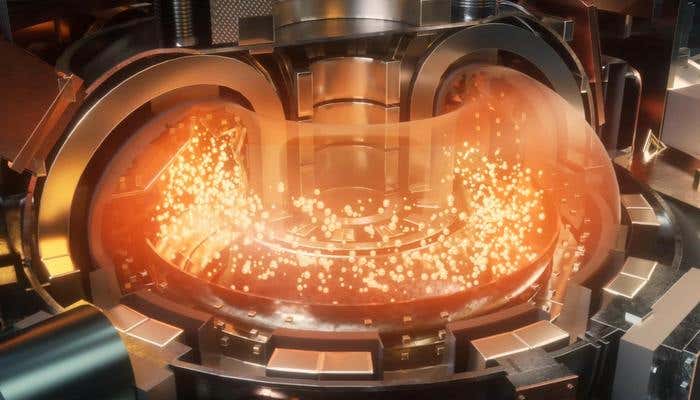Chinese “Artificial Sun” achieves fusion energy milestone
China’s “artificial sun,” sets a new record in fusion energy research, bringing humanity closer to limitless, clean energy.

The Experimental Advanced Superconducting Tokamak (EAST), often referred to as China’s “artificial sun,” set a new global record. (CREDIT: HFIPS)
The quest for harnessing nuclear fusion, the process that powers the sun, has taken a groundbreaking leap forward. On Monday, the Experimental Advanced Superconducting Tokamak (EAST), often referred to as China’s “artificial sun,” set a new global record.
Researchers maintained a steady-state high-confinement plasma for an astonishing 1,066 seconds. This achievement, spearheaded by the Institute of Plasma Physics at the Hefei Institutes of Physical Science, surpasses the previous record of 403 seconds set by EAST in 2023. Such progress underscores the immense strides being made in fusion energy research.
Pushing the Limits of Fusion Energy
Nuclear fusion holds the promise of a virtually limitless, clean energy source by replicating the sun’s fusion processes on Earth. For over 70 years, scientists have worked tirelessly to bring this concept to reality.
Achieving temperatures exceeding 100 million degrees Celsius is just one of the many hurdles. Stability and long-term operation of the plasma—the charged gas where fusion reactions occur—are equally critical.
“A fusion device must achieve stable operation at high efficiency for thousands of seconds to enable the self-sustaining circulation of plasma, which is essential for the continuous power generation of future fusion plants,” explained Song Yuntao, director of the Institute of Plasma Physics and vice president of the Hefei Institutes of Physical Science. The recent record marks a significant milestone in achieving this goal.
Continuous innovation has been central to EAST’s progress. Since its launch in 2006, the tokamak has served as a platform for global research in fusion energy. The latest milestone reflects the effectiveness of recent system upgrades.
Gong Xianzu, head of EAST’s Physics and Experimental Operations division, highlighted the improvements. The device’s heating system—already capable of matching the combined power of nearly 70,000 household microwave ovens—has now doubled in power. This increased output, coupled with enhanced stability, has enabled longer plasma confinement times, bringing scientists closer to achieving self-sustaining fusion.
Related Stories
A Global Collaborative Effort
The success of EAST is not just a win for China but a significant contribution to global fusion research. As a member of the International Thermonuclear Experimental Reactor (ITER) project since 2006, China has played a crucial role in advancing fusion technology. ITER, under construction in southern France, aims to become the world’s largest experimental nuclear fusion reactor.
China’s involvement in ITER includes contributing approximately 9 percent of the project’s construction and operation. The insights gained from EAST provide valuable data for ITER and other experimental reactors like the planned China Fusion Engineering Test Reactor (CFETR).
The CFETR utilizes and intends to build upon pre-existing nuclear fusion research from the International Thermonuclear Experimental Reactor (ITER) program in order to address the gaps between ITER and the next generation thermonuclear plant and successor reactor class to ITER, the Demonstration Power Plant (DEMO).
The China Fusion Engineering Test Reactor (CFETR) will operate in two phases. In the first phase, the CFETR will be required to demonstrate steady state operation and tritium self-sufficiency with a tritium breeding ratio > 1. Moreover, in Phase 1, the CFETR should demonstrate generation of fusion power up to 200MW.
The second phase, the DEMO validation phase, requires the CFETR to generate power over 1 GW. More generally, the CFETR will also serve as a research and development tool for the testing of various structural and functional materials to identify or develop a material with a high neutron flux resistance.
Song emphasized the importance of international collaboration in advancing fusion research, saying, “We hope to expand international collaboration via EAST and bring fusion energy into practical use for humanity.”
EAST’s success paves the way for further advancements in fusion technology. New experimental facilities are under construction in Hefei, aiming to accelerate the application of fusion energy. These facilities will build on the knowledge gained from EAST, providing a testing ground for technologies critical to future fusion power plants.
The implications of these developments extend far beyond the scientific community. Fusion energy has the potential to address many of the world’s energy challenges. By offering a virtually inexhaustible power source without the greenhouse gas emissions associated with fossil fuels, fusion could play a pivotal role in combating climate change.
As EAST continues to set records and refine its technology, the dream of a fusion-powered future feels increasingly within reach.
These achievements bring humanity closer to harnessing the same energy that powers the stars, promising a cleaner and more sustainable energy future.
Note: Materials provided above by The Brighter Side of News. Content may be edited for style and length.
Like these kind of feel good stories? Get The Brighter Side of News' newsletter.
Rebecca Shavit
Science & Technology Journalist | Innovation Storyteller
Based in Los Angeles, Rebecca Shavit is a dedicated science and technology journalist who writes for The Brighter Side of News, an online publication committed to highlighting positive and transformative stories from around the world. With a passion for uncovering groundbreaking discoveries and innovations, she brings to light the scientific advancements shaping a better future. Her reporting spans a wide range of topics, from cutting-edge medical breakthroughs and artificial intelligence to green technology and space exploration. With a keen ability to translate complex concepts into engaging and accessible stories, she makes science and innovation relatable to a broad audience.



